Out in November, purchasable in September. Contact IUP for reviewer copies “Rethinking Virtual Places” (in the IUP Spatial Humanities series) https://iupress.org/9780253058355/rethinking-virtual-places
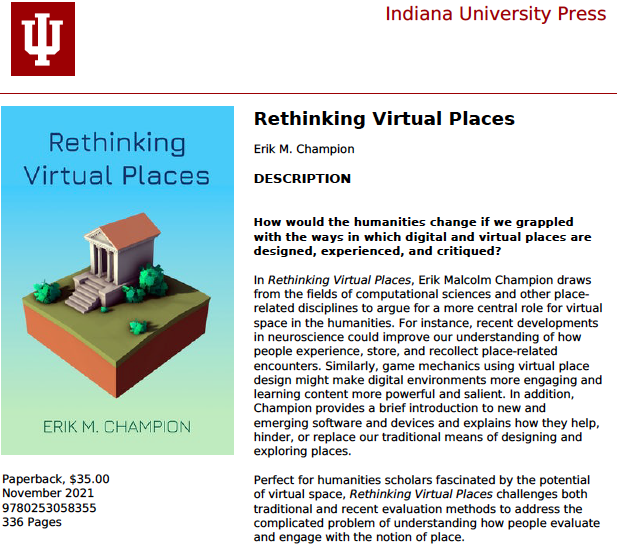

Out in November, purchasable in September. Contact IUP for reviewer copies “Rethinking Virtual Places” (in the IUP Spatial Humanities series) https://iupress.org/9780253058355/rethinking-virtual-places

Dear Rosa and Andrea (and Michael)
Thanks to the colleagues and co-authors who helped inspired me to edit a concise book for students that will be open access (i.e. free PDF downloads).
Virtual Heritage: A Guide will be available on Thursday 22 July 2021 at https://www.ubiquitypress.com
I’d appreciate any feedback from staff or students for future editions.

I have been informed, that if there are no major holdups the above will be available as a free online book from Ubiquity Press in July 2021. Cover image courtesy of Michael Carter.
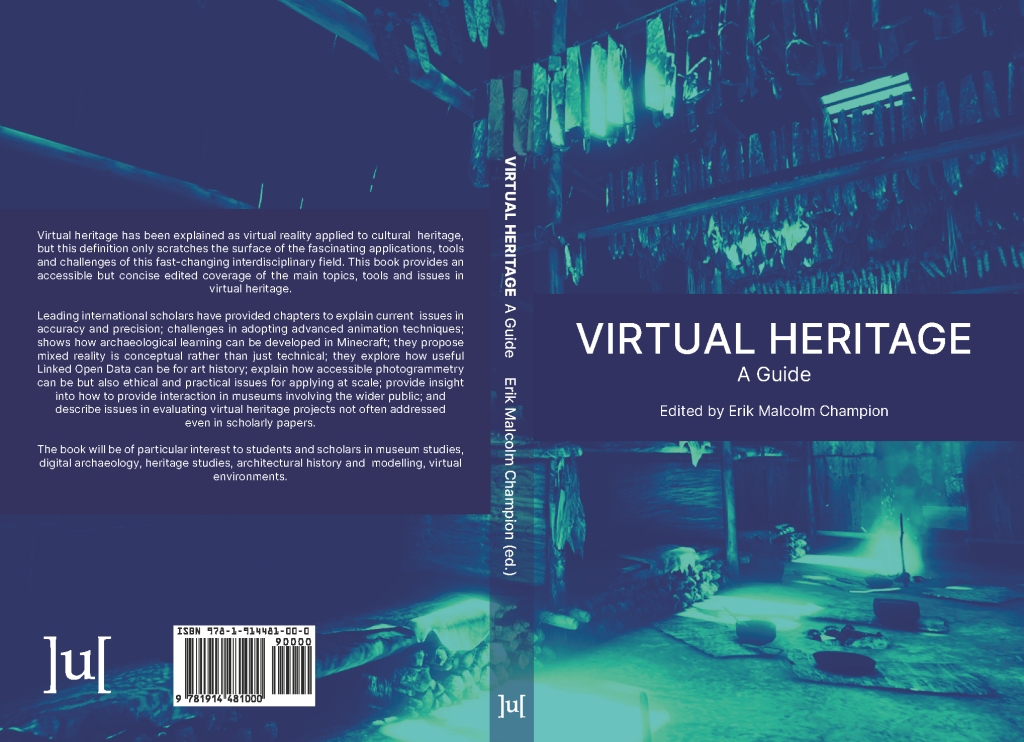
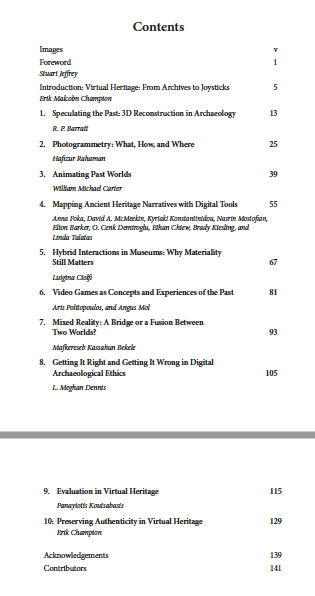
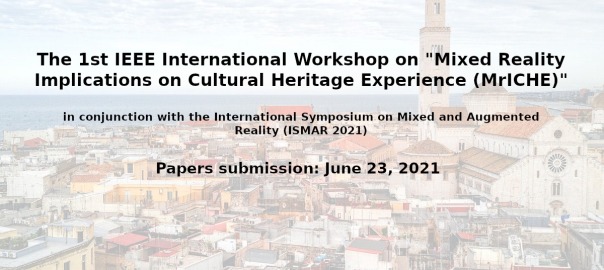
#CFP I was invited onto the program committee for IEEE International Workshop on “Mixed Reality Implications on Cultural Heritage Experience (MrICHE)”.
The workshop will be held in conjunction with the International Symposium on Mixed and Augmented Reality (ISMAR 2021, https://ismar21.org), 4-8 October 2021, Bari, Italy.
Submit: 4-8 page papers by 23 June! IEEE format. https://fcrlab.unime.it/calls/mriche2021 #ismar #culturalheritage #mixedreality #augmentedreality
This is our proposed draft chapter (7500-9000 words) for a book on medieval modding within a game (Elder Scrolls V: Skyrim).
Ear Zow Digital, Australian National University, University of Western Australia
Terhi Nurmikko-Fuller, Australian National University
Katrina Grant, Australian National University
Elder Scrolls V: Skyrim, through its rich modding possibilities, has great potential as a teaching and learning tool. The world of Skyrim, although “pseudo-medieval”,[1] can, through the use of mods, aim for a level of historical accuracy comparable to many scholarly digital 3D reconstruction projects. These types of projects are now widely accepted as a vehicle for a new way of thinking about old topics, and as a valuable prompt for engaging students. The advantage of using Skyrim is that the historically informed mods can be combined with sophisticated game mechanics to immerse and inspire students as procedural, contestable, and reconfigurable simulations. Through playful exploration, students can investigate the game world and engage with both the historically-informed and fantastical elements. But they can also become designers, and investigate historical developments through the creation of new assets, modified game mechanics, and social storytelling. Designing simulations is a further learning experience and Skyrim’s Creation Kit is thus also a pedagogical tool.
In this chapter we will explore ways in which Skyrim can be used and modified to explain, through play, three related aspects of medieval society: culture, architecture, and landscape. We will then discuss the modding capability of Skyrim, and conclude with some suggestions for how future Elder Scrolls games and game mods could be leveraged as a teaching and learning tool.
[1] von Lünen, Alexander, Katherine J Lewis, Benjamin Litherland, and Pat Cullum. 2019. Historia Ludens: The Playing Historian. Vol. 30. New York, USA: Routledge.
Virtual Archaeology Review declared my and Dr Rahaman’s 2020 paper “Survey of #3D digital heritage repositories and platforms” their paper of the year.
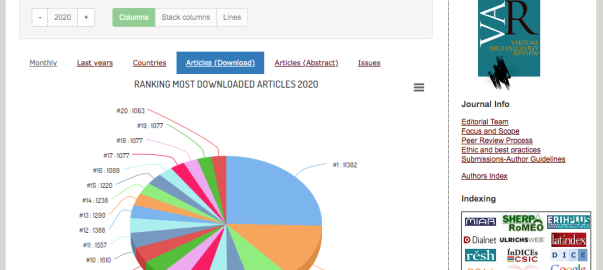
I am impressed that the Virtual Archaeology Review Journal (@VARjournal) has a stats page with % comparing views to downloads and abstracts listed (and a 3D -model- filter!) It can help authors check their abstract is on target (i.e. catchy). Our (with Dr Hafizur Rahaman @hafi2018) 2020 article Survey of 3D digital heritage repositories and platforms was 6th most downloaded article (3rd for 2020). NB had trouble viewing, had to refresh several times.
CHAMPION, Erik; RAHAMAN, Hafizur. Survey of 3D digital heritage repositories and platforms. Virtual Archaeology Review, [S.l.], v. 11, n. 23, p. 1-15, July 2020. ISSN 1989-9947. Available at: <https://polipapers.upv.es/index.php/var/article/view/13226>. Date accessed: 04 Jan. 2021. doi:https://doi.org/10.4995/var.2020.13226.
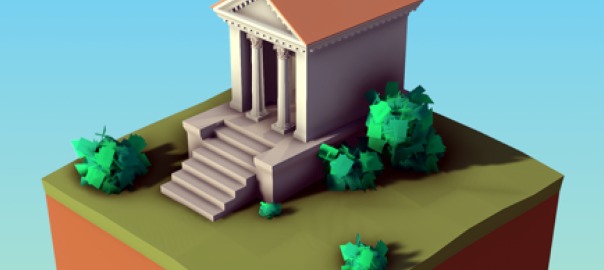

Was one of two book covers possible and I think due to some email confusion they didn’t choose my preferred cover but I really appreciate permission by Dr Anthony Masinton to use his rendered image. The publisher of Rethinking Virtual Places will be Indiana University Press, via their Spatial Humanities Series.

My presentation slides for virtual The Interactive Pasts Conference Online 2 (TIPC2), (held 5-6 November, notionally, at Leiden) are on slideshare.
The twitch stream for the conference is at https://www.twitch.tv/valuefnd (my talk from yesterday is on there somewhere).
This paper explores Assassin’s Creed: Odyssey as a way to explore idyllic historic landscapes and heritage sites with some degree of questing and simulated danger. It applies Assassin’s Creed: Odyssey in two ways, as discovery tour option mode and as a metaphor to explore in more general and speculative terms how questing and historical dilemmas and conflicts could be incorporated into both fan tourism and cultural/historical tourism (Politopoulos, Mol, Boom, & Ariese, 2019).
Keza MacDonald views Assassin’s Creed as a virtual museum, Ubisoft regards it as the recovery of lost worlds: “ “We give access to a world that was lost” said Jean Guesdon (MacDonald, 2018). “Discovery Tour will allow a lot of our players to revisit this world with their kids, or even their parents.”
Origins’ Discovery Tour mode “promises” educational enlightenment (Thier, 2018; Walker, 2018); Odyssey’s additional Story Creator Mode (Zagalo, 2020) adds personalized quests. Beyond the polaroid fun of sharing landscape selfies with other players and ancient history voyeurs across the Internet, there is also the prospect of “Video game–induced tourism: a new frontier for destination marketers” (Dubois & Gibbs, 2018). Plus physical location VR games. Game company Ubisoft created escape game VR and virtual tours inside physical exhibitions such as Assassin’s Creed VR – Temple of Anubis (Gamasutra Staff, 2019). Is there a market for historical playgrounds as virtual tourism?

I’m very happy that my rather large article “Culturally Significant Presence
In Single-Player Computer Games” has been accepted for the ACM Journal on Computing and Cultural Heritage. This is despite its 12,587 words covering 4 major games, and attempting to be more conceptual and provocative than normal in a traditional ACM IT-oriented journal..
Very good reviewers too, actually. They made me work hard. I think my abstract is a bit over JOCCH length so that may change but at moment it is:
Cultural presence is a term that researchers have used to explain and evaluate cultural learning in virtual heritage projects, but less frequently in video games. Given the increasing importance of video games to cultural heritage, this paper investigates explanations of cultural presence that could be communicated by games, especially concerning UNESCO and ICOMOS definitions of cultural significance. The aim is to determine if cultural presence can be communicated via video games and across a range of game genres.
Observations derived from game prototyping workshops for history and heritage were incorporated to help develop a teachable list of desirable game elements. To distinguish itself from the vagueness surrounding theories of cultural presence, a theory of culturally significant presence is proposed. Culturally significant presence requires three components: culturally significant artifacts and practices; an overarching framework of a singular, identifiable cultural viewpoint; and awareness by the participant of both the culturally significant and the overarching cultural framework and perspective (which gives cultural heritage sites, artifacts and practices their cultural significance and relational value).
As awareness of cultural presence requires time to reflect upon, single-player games were chosen that were not completely dependent on time-based challenges. Another criterion was cultural heritage content, the games must simulate aspects of cultural heritage and history, communicate a specific cultural framework, or explore and reconstruct a past culture. Four games were chosen that simulate a culture, explain archaeological methods, portray indigenous intangible heritage, or explain historical-based ecosystems of the past based on educational guidelines. The games are Assassin’s Creed: Origins (and its Discovery Tour); Heaven’s Vault; Never Alone; and a Ph.D. game project: Saxon. Their genres could be described as first-person shooter/open world/virtual tour; dialogue-based puzzle game; 2D platform game; and turn-based strategy game.
The aim is not to evaluate the entire range of interactive and immersive virtual environments and games, but to examine the applicability and relevance of the new theory, and to ascertain whether the four games provided useful feedback on the concept and usefulness of culturally significant presence. A more clearly demarcated theory of cultural presence may not only help focus evaluation studies but also encourage game developers to modify or allow the modification of commercial games for classroom teaching of digital heritage. Game content, core gameplay, secondary gameplay, and game mechanics could be modified to engagingly compel players to consider cultural heritage values and perspectives that are not their own.
The editor of Virtual Archaeology Review has kindly created a shout out to our recent article “Survey of 3D digital heritage repositories and platforms” (in Vol. 11 no. 23, 2020):
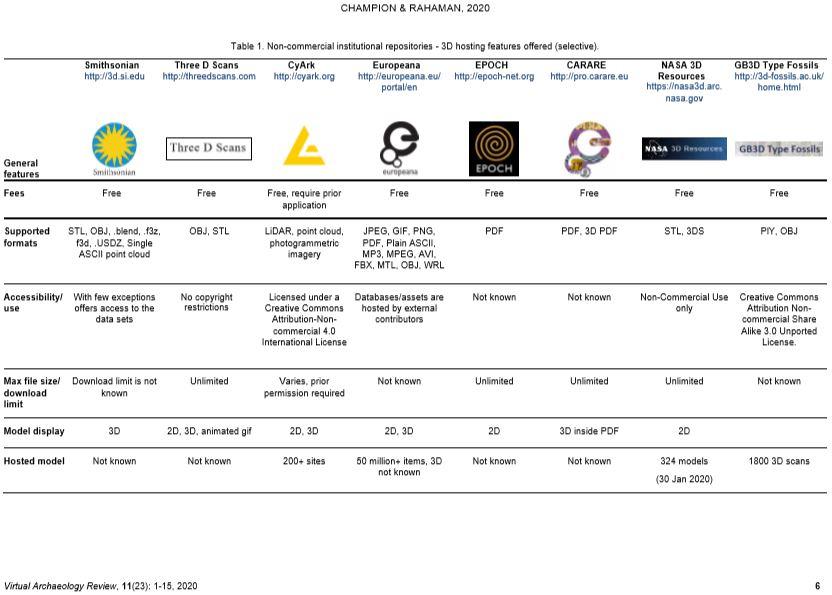
Hello, with eight authors for eight chapters I am proposing a concise guide on virtual heritage to publishers. I believe I have been allowed UNESCO chair/Curtin funding to pay publishing open access fees (so the book can be free as online PDFs) and hopefully reasonably priced to purchase.
I believer we now have two recommendations for external reviewers but we still need to get all author chapter abstracts ready and the proposal to the publisher for approval. Each chapter will be a taut 3500 words with 1-3 images.
Given the book is aimed at graduate or senior undergraduate students who may not be familiar with an overview or specific topics of virtual heritage, what title is best?
Virtual Heritage in Focus?
Virtual Heritage: A Concise Guide?
Also, are we missing an important chapter/theme subject?
Foreword: Classrooms and Projects
Preamble
Glossary

Cultural Heritage Infrastructures in Digital Humanities (2017) is free to access for one week, get free access to the book (via this link) for 7 days.
After this 7-day period, you can buy a copy for £10/$15!
You can also visit the official Routledge History, Heritage Studies etc. Twitter page
and thanks to Routledge editor Heidi Lowther.
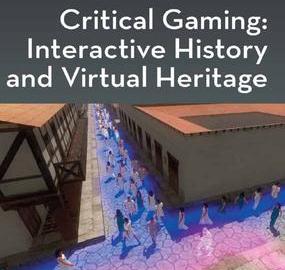
Critical Gaming: Interactive History and Virtual Heritage (2015 edition) is in a Routledge campaign for May (2020), which allows anyone to register and get free access to the book (via this link) for 7 days. After this 7-day period, they can buy a copy for £10/$15! *Trust me this is a lot cheaper than before!
Also check out the official Routledge History, Heritage Studies etc. Twitter page
Is there a catch? I honestly don’t know but don’t think so!
PhD Studentship: AHRC Collaborative Doctoral Partnership PhD in Archaeology: Digital Recording, Fieldwork and Craft at Museum of London Archaeology
Anticipated start date for project: 1 October 2020
Closing date for applications: 1 May 2020 (was 1 April)
(interviews w/c 17 May)
Project description:
This Arts and Humanities Research Council (AHRC) Collaborative Doctoral Partnership (CDP) PhD, Digital Recording, Fieldwork and Craft at MOLA (Museum of London Archaeology) investigates the impact of digital methods on the documentation, interpretation, publication, and dissemination in archaeological knowledge production. The proposed PhD will evaluate digital recording strategies for commercial archaeological units, using MOLA as a primary case study and with consultation from the Archaeology Data Service. Previous studies of digital recording have focussed on academic projects that do not have the scope, impact or challenges of the large, ongoing projects such as those performed regularly at MOLA. This research also examines the process of how archaeologists interpret remains, understand the past and how we may better transmit this understanding to others. Work in this area is emerging and applicable to broader questions of learning.
Potential research questions:
These are potential research questions for the student to undertake; the successful applicant will be able to shape the PhD with the support of the student’s supervisors.
This project will be jointly supervised by Dr Colleen Morgan (University of York) and Louise Fowler (MOLA). The student will be expected to spend time at both York and MOLA, as well as becoming part of the wider cohort of CDP funded students across the UK.
Funding notes:
AHRC CDP doctoral training grants fund full-time studentships for 45 months (or part-time equivalent). The studentship has the possibility of being extended for an additional 3 months to provide professional development opportunities, or up to 3 months of funding may be used to pay for the costs the student might incur in taking up professional development opportunities.
The studentship covers (i) a tax-free annual stipend at the standard Research Council rate (£15,285 for 2020-2021), (ii) an allowance of £1000/year to enable collaboration with the partner organisation (as they are based in London), (iii) an additional allowance of £1000/year for expenses incurred in undertaking research, and (iv) tuition fees at the UK/EU rate.
Entry requirements: Students with, or expecting to gain, at least an Upper Second Class Honours degree, or equivalent, are invited to apply. The interdisciplinary nature of this research project means that we welcome applications from students with backgrounds in any relevant subject that provides the necessary skills, knowledge and experience for the project, including archaeology, user-experience design and computing, anthropology, and digital sociology. We endeavour to be inclusive and flexible regarding applicants with caring obligations, disabilities and other considerations.
Nationality restriction:
Candidates must have a relevant connection with the UK to qualify for a full AHRC award, i.e. they must have been ordinarily resident in the UK throughout the three-year period preceding the date of application, or have settled status in the UK. Non-EU candidates who have not been ordinarily resident in the UK for the last three years, or who were resident wholly or mainly for the purposes of education, are not eligible to apply.
Candidates from EU countries are eligible for full awards if they have been resident in the UK, for education or other purposes, for at least three years prior to the start of their programme. Candidates from EU countries who have not resided in the UK for three years prior to the start of their programme will normally be eligible for a fees-only award.
The University is committed to promoting a diverse and inclusive community – a place where we can all be ourselves and succeed on merit. We offer a range of family friendly, inclusive employment policies, flexible working arrangements, staff engagement forums, campus facilities and services to support staff from different backgrounds.
We particularly encourage applications from BAME, LGBTQ+ and disabled candidates, who are currently under-represented within the University of York in Archaeology.
How to apply:
Application is by covering letter, CV and online application form, and should be made through the University of York online application system.
Please read the ‘How to apply’ tab before submitting your application: http://www.york.ac.uk/archaeology/postgraduate-study/research-postgrads/application/
Further Enquiries
For further enquiries, please contact Colleen Morgan (colleen.morgan@york.ac.uk).
I am not sure, but it appears the reason for my use of the word “realms” in “Explorative Shadow Realms of Uncertain Histories“* may not be clear to people who quote me.
In “Negotiating ‘Culture’, Assembling a Past: the Visual, the Non-Visual and the Voice of the Silent Actant” [http://hdl.handle.net/2077/30093] Jonathan Westin wrote:
In the introduction to article 2, my co-author Thommy Eriksson and I write:
“Our cultural heritage is increasingly experienced as a virtual heritage, a space, or realm as Champion puts it (2008), consisting of representations.
Three-dimensional scanning through photogrammetry and laser, virtual reality, augmented reality, photorealistic computer graphics and interactive displays; all these are technologies that in days to come will shape the profession of both archaeology and museology” (article 2, p. 87-88).
I used realm in the sense of an area where the social rules/laws have as much influence on people as physical ones. My intention was to suggest this is not a common feature of virtual heritage environments, but to explain culture, perhaps it could and should be. I was not trying to suggest a field or that digital technology is creating a culturally meaningful or completely inclusive “world” (in the past I have defined virtual worlds in at least three markedly different ways). Virtual reality does not only have to mirror physical reality. Physical reality is not a 1:1 relationship to experienced reality.
There is another passage which may or may not correlate to what I thought I meant by uncertainty, Westin wrote:
I consider the communication of uncertainty to be a key element, and in two of the articles my co-authors and I propose different visual signifiers conveying insufficient data (article 1 and 2). For an exchange to be productive, both parties have to be able to communicate uncertainty. To return to the example above, the exact, certain, image representation of a banister appears to be non-negotiable, even though it may be based on insufficient data, while a representation that communicates its uncertainty invites other actants to question its form.
I have however, in Critical Gaming, and in Playing With the Past, wrestled with notions of realm, world, and uncertainty. I hope to write a chapter in an upcoming book, on authenticity. But, in short, I probably will have to go back to this term and write a clearer summary.
*The 2007 Explorative Shadow Realms book chapter (for New Heritage, Kalay et al) is the same content as the 2006 conference paper.
February 17-18, 2020, The CREASE
University of South Australia, Kaurna Building Level 2, City West Campus
This workshop will explore examples of how the application of digital technologies in the humanities, built environment, creative arts and design are affecting how heritage environments are studied, preserved, shared and celebrated. The advent of technologies such as LIDAR (Laser scanning of natural and built environments), Virtual and Augmented Reality and immersive interactive environments, in areas such as site data collection, site visualisation and heritage exhibitions, are transforming how we study heritage environments and experience them both in situ and elsewhere. These changes have implications in diverse domains, including archaeology, anthropology, museology, tourism, architecture, restoration and education.
Day 1 Monday February 17, 2020
13:00 Welcome to Country
A/Prof. Jane Lawrence, Head: School of Art, Architecture and Design
13:15 Introduction to the day, Prof. Simon Biggs
13:30 Keynote: Prof. Erik Champion, Curtin University, Perth (Chair: Prof. Ning Gu)
Prof. Champion is UNESCO Chair of Cultural Heritage and Visualisation, and Professor of Media Culture and Creative Arts, in the Humanities Faculty of Curtin University, Perth, Western Australia.
14:45 Q&A
15:00 coffee and networking – Catered by Folk Lore
15:30 Burra Digital Heritage Project: Dr. Julie Nichols and Darren Fong
16:30 Discussion
17:00 Drinks at West Oak Hotel
Day 2 Tuesday February 18, 2020
09:00 coffee and networking – Catered by Folk Lore
09:30 Presentation 1 – Dr. Aida Eslami Afrooz – Time Layered Cultural Map project
10:15 Presentation 2 – CAD Walk – immersive environments for heritage simulation
11:30 Presentation 3 – Dr. Gun Lee – Augmented Reality in Outdoor Experience
12:15 Discussion
12:30 Lunch – Catered by Folk Lore
13:30 Presentation 4 – Sahar Soltani – The HYVE (in the HYVE)
14:15 Presentation 5 – Ben Keane and Alex Degaris Boot – AR for Heritage (in CCS)
15:00 coffee and networking
15:30 Discussion
16:00 end.
Dear CAA member or ex-member, If you are interested in running a workshop on Tuesday, 14th April before the CAA 2020 conference starts, please email us at caa2020@arch.ox.ac.uk. Please provide us with the title of the workshop, a short (250 words or less) abstract of the workshop and what attendees will learn by attending it. Please also include a list of any equipment you might need (i.e. LCD projector, etc.) to successfully deliver your workshop. As the organisers will not provide computers for the attendees, please do remember to list all the items that will be required for participation (laptop, notepad, software). Please also indicate whether your workshop will be a full day or half day session, and whether you wished to set maximum numbers for attendees. Please submit your abstract by 12th February 2020 (midnight). Please contact the organisers at caa2020@arch.ox.ac.uk for clarification or further inquiries.
Champion, Erik. “From Historical Models to Virtual Heritage Simulations”. Chap. 4 In Der Modelle Tugend 2.0 Digitale 3d-Rekonstruktion Als Virtueller Raum Der Architekturhistorischen Forschung Computing in Art and Architecture, edited by Piotr Kuroczyński, Mieke Pfarr-Harfst and Sander Münster, 337-51. Heidelberg, Germany: arthistoricum.net, 2019. https://books.ub.uni-heidelberg.de/arthistoricum/catalog/book/515